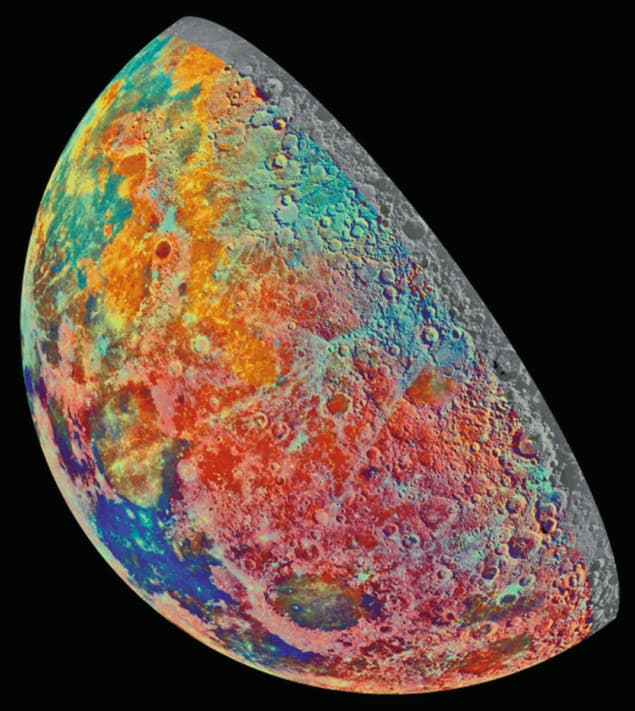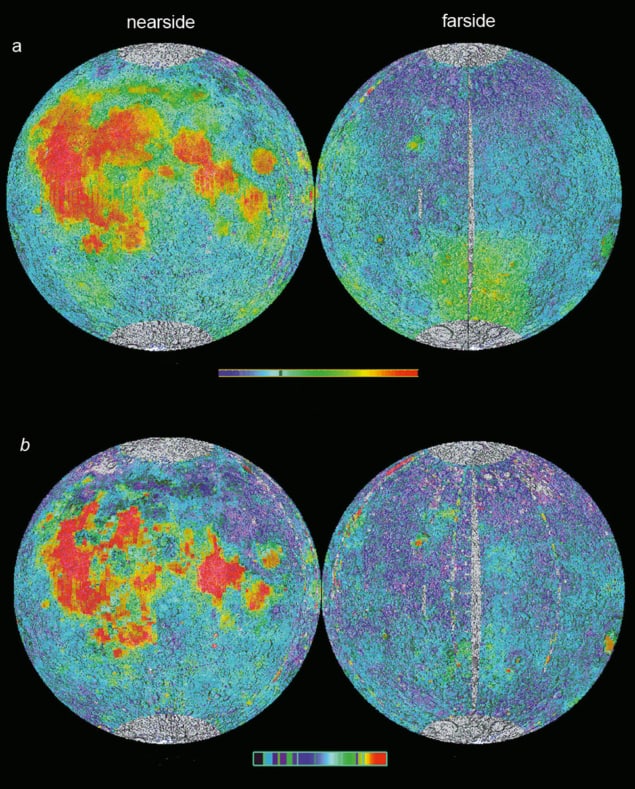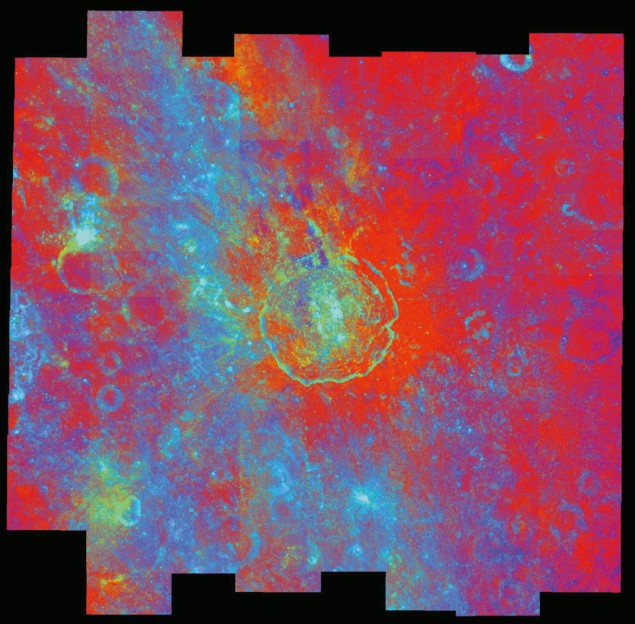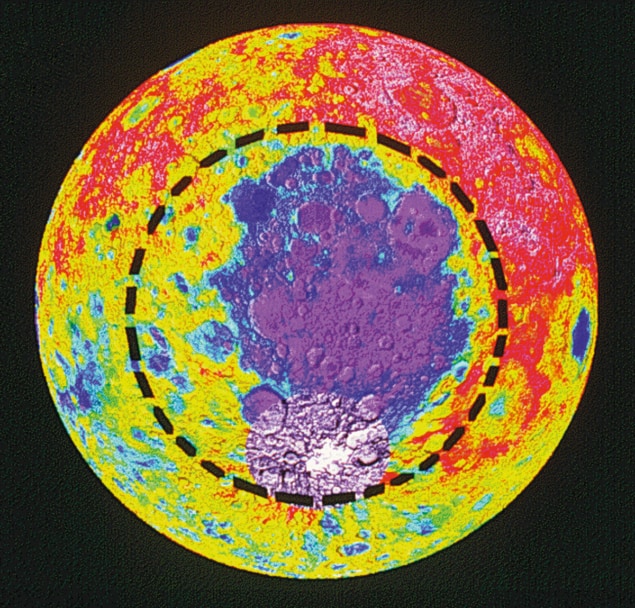In July 1969 Neil Armstrong took man’s first steps on another world, yet 30 years on, the Moon still holds many mysteries that we are only just beginning to unravel.

The Moon is our closest neighbour in space and holds the key to unlocking the secrets of the inner solar system. It is the most studied planetary body other than the Earth, and 30 years ago provided the scene for what is arguably mankind’s greatest achievement: our first steps on an extraterrestrial body.
On 21 July 1969 Neil Armstrong became the first man to walk on the Moon. By the end of 1972, a total of twelve men had walked on the lunar surface. In addition, numerous craft had visited our neighbour armed with various sensors designed to examine it in almost every conceivable manner. There were many problems to solve. How did the Moon form and evolve? What is it made from? Is it still geologically active, and if not, when did activity cease? What was the nature of the volcanic activity that formed the vast, dark plains visible from Earth? Despite several missions to the lunar surface, many of these questions remained unanswered and the Moon has refused to surrender its most precious secrets.
Until the Clementine and Lunar Prospector missions were launched in the 1990s, an entire generation had never witnessed a major lunar mission. So why have we returned to the Moon after so long? What did we learn from the Apollo missions? Where do we stand now after the recent successes of Clementine and Lunar Prospector? And, perhaps most importantly, where do we go from here?
The Apollo era
It was inevitable that science would benefit greatly from the political drive to send a man to the Moon. Indeed, without the “Apollo incentive” many of the earlier spacecraft missions would never have flown. The golden age of lunar exploration, from 1959 to 1976, saw a whole range of spacecraft fly to the Moon. These included the five “Lunar Orbiter” reconnaissance missions that provided a magnificent, near-global photographic dataset that is still used extensively today. However, the jewel in the crown for lunar scientists unquestionably came in the form of more than 380 kg of rock and soil samples collected by the six manned Apollo landings and two of the unmanned Luna missions.
Before we had these samples, scientists were forced to infer the Moon’s history based on geological interpretations of photographs. The Apollo missions provided the “ground truth” for these observations. They confirmed that the bright lunar highlands were composed primarily of the coarse-grained igneous rock anorthosite, while the smooth dark plains, known as maria, were composed of the volcanic rock basalt. These two terrains form the familiar light and dark markings on the Moon that are visible with the naked eye. The lunar-soil samples showed the highland anorthosites were considerably less dense than the basalts on the maria. Furthermore, the highland rocks were rich in the trace element europium, while the basalts had a corresponding depletion.
In combination with other results, these factors were vital in the formulation of the “magma-ocean hypothesis”, detailing the early evolution of the Moon. This theory, which was proposed in the early 1970s, is still advocated today, albeit in a modified form. According to this theory, in its early life the upper layers of the Moon were molten. During this time the melt differentiated, with the heavier minerals sinking and leaving the less dense minerals to solidify and form the highland crust. The heavier minerals left beneath the crust would have remained molten for some time, and later erupted onto the surface to produce the vast mare plains we see today. This volcanic activity ceased sometime between 2.5 and 3 billion years ago, and since then the only action to have altered the lunar surface has been the impact of meteorites, asteroids and comets.

The lack of wind or water erosion on the Moon means that the highland crust now holds a record of the events that date right back to its birth. Asteroids and meteors would have bombarded the rest of the inner solar system, and particularly the Earth, in a similar way to the Moon. The record of lunar craters therefore provides us with a glimpse of how conditions in the inner solar system changed over time. Observing the lunar crust in detail is therefore of the utmost importance if we are to describe the conditions in the inner solar system from the creation of the Moon to the present day.
The Apollo missions and unmanned spacecraft provided us with major clues to the evolution of the Moon and its local environment, from which models were developed. But scientists required a lot more information about the composition of the Moon on a global scale in order to confirm and refine these models. The remote observations from Apollo were restricted to equatorial regions and covered just 15-20% of the lunar surface. In addition, large variations were observed within these areas, making it impossible to extrapolate the results to include other parts of the Moon.
Astronomers learned about the composition of the Moon by analysing the light reflected from the lunar surface with Earth-based telescopes – a technique known as reflectance spectroscopy. The lunar rock and soil samples brought back by the Apollo astronauts were crucial in helping to calibrate the data. Although this technique has proved valuable for large-scale compositional analyses of the lunar terrain, our view from Earth is restricted to just one hemisphere. Another space-based mission was needed to gather data from the farside of the Moon. Unfortunately, after the last Apollo mission, interest in the Moon waned as it became more feasible to explore other planets in the solar system.
Return to the Moon
We had to wait until 1990 before a spacecraft studied the Moon again. The Jupiter-bound Galileo craft turned its multi-spectral cameras to the Moon during flybys in 1990 and 1992, giving us a taste of the science to come.
In January 1994 the US Department of Defense launched the Clementine mission, designed to test new, lightweight technology for satellite systems. NASA provided the scientific payload, which included two multi-spectral cameras with filters targeted at specific features found in the spectrum of lunar soils and rocks returned by Apollo. Two months in lunar orbit saw the return of over 1 million digital images in 11 wavebands, ranging from 415 nm in the visible to 2792 nm in the near-infrared, providing the first ever global spectral dataset of the Moon.

Despite the poor spectral resolution of Clementine compared with the Earth-based observations, the results immediately showed that the Moon’s iron and titanium were concentrated in the maria (figure 2). Although various analyses of the Apollo samples and reflectance spectroscopy had hinted at this, these data were restricted to the nearside. Clementine provided the first global view. Knowing the distribution of elements on the Moon is crucial to models of its origin and evolution, so determining the distribution of iron and titanium across the whole of the Moon was an important advance in our understanding.
The Clementine data have a high spatial resolution, typically 80-300 m per pixel, compared with the Earth-based observations, which have a resolution of 2-3 km. The new results therefore allowed scientists to look at compositional variations on a much smaller scale, and how they relate to specific processes such as impact cratering.
Large asteroids have penetrated deep into the lunar crust, excavating material from beneath the surface and depositing it in an annulus round the impact crater (figure 3). By studying this excavated material, we can gain direct compositional information about the layers below the surface and the vertical structure of the lunar crust. Studies of many suitable craters will therefore allow us to build up a 3-D image of the Moon’s composition.
At the other end of the scale, the smallest craters resolvable by Clementine can be used to examine the thickness of individual lava flows in the maria. This information will help us to understand the nature of the volcanic episodes that produced the flows, and imply how the thermal properties of the Moon changed over time. This is an important uncertainty in current models of lunar evolution.

Topographic data sent back from Clementine have also made it possible to study some of the oldest and most degraded impact basins on the Moon, such as the South Pole-Aitken Basin on the farside (figure 4). At 2500 km in diameter, it is the largest known impact structure in the solar system. The crater has a depth of 13 km from rim crest to basin floor, and the impact may even have excavated material from the lunar mantle. If this is the case, then compositional analysis will allow us to look deeper into the lunar interior than ever before.
Currently it is difficult to identify material from the mantle because we do not have any samples and must infer its composition indirectly. Paul Lucey and colleagues from the Hawaii Institute of Geophysics and Planetology, and the Lunar and Planetary Institute in Houston found a high abundance of iron and titanium in the basin relative to the surrounding highlands. From this they inferred that the South Pole-Aitken Basin contains a mixture of lower-crustal material and mantle rock, with the mantle containing up to 20% iron oxide and only 0.1% titanium dioxide by weight. It is true that other explanations can fit the data, but the only way to resolve the situation for certain is to go there and collect a sample.
Water on the Moon
Perhaps the most exciting of all Clementine’s discoveries stemmed from images of the lunar poles. The plane of the Moon’s orbit has a very low inclination (1.5°) to the plane of the Earth’s orbit about the Sun, which means that incident solar radiation is almost horizontal at the poles. Clementine found hilly areas and crater rims in the southern polar region that receive illumination for a large percentage of the lunar day (figure 5). Likewise, in deeper craters there are also areas that remain in permanent shadow (totalling around 30,000 km2) that are cold enough for water-ice to be stable.

It was therefore only natural that when the results from a bistatic-radar experiment on board Clementine were analysed and showed an anomalous signal over the south pole, many immediately interpreted this as representing deposits of ice. This was a controversial deduction and the result could not be confirmed by the other instrumentation on board Clementine. Fortunately, another mission was already in the pipeline that could shed more light on the situation.
Four years later, in 1998, NASA launched “Lunar Prospector” its first dedicated lunar mission since the end of the Apollo programme in 1972. It carries five instruments ranging from a gamma-ray spectrometer to a magnetometer and electron reflectometer (see box). Each instrument has a focused scientific objective and is designed to provide global information to complement the existing data. In December 1998 Lunar Prospector completed its year-long primary mission and began a more detailed “extended mission”. During the extended mission the spacecraft’s orbit was lowered from 100 km down to just 25 km, where it started to refine its previous measurements.
Lunar Prospector has confirmed the presence of ice deposits at the south pole from measurements made using its neutron spectrometer (figure 6). Although the device cannot detect water directly, it can locate concentrations of hydrogen. The conditions on the Moon are such that the hydrogen is most likely to be locked within ice molecules. Lunar Prospector found an even greater concentration of ice at the north pole, suggesting that there could be up to 3 billion tonnes of water at each pole. The result was a surprise as the earlier Clementine mission was unable to clearly detect anything in this region.
To put this result into perspective, it is estimated that each person in London uses 55 000 litres of water per year for drinking, washing, preparing food, etc. If we could obtain just 1% of the Moon’s water, it would support 2000 Londoners for over 500 years. Hence, if the presence of water at the poles can be confirmed by a direct-sampling mission, it will have huge implications for the long-term future of lunar exploration.
While Lunar Prospector orbits at the lower altitude the neutron spectrometer will make more detailed measurements and give us an even better idea of the quantity of hydrogen present. But the true nature of any water deposits (i.e. purity, depth, accessibility, etc) will require in situ measurements of rocks, soils and cores.
Elements and gravity
One of Lunar Prospector’s most important objectives is to use the on-board gamma-ray spectrometer to map the distribution of the key elements that make up 98% of the Moon’s mass. The measurements will help to constrain models of the bulk composition of the lunar crust, a key unknown in lunar-origin models. Previous data suggest that the Moon is rich in refractory elements, such as aluminium, thorium and uranium. If this is confirmed, it will have a bearing on models that suggest the Moon was formed from material thrown off from the Earth.
Similarly, the distribution of material rich in KREEP (potassium, K, rare-earth elements, REE, and phosphorus, P) is vital in testing theories of lunar evolution. The rocks containing KREEP are believed to have formed at the crust-mantle boundary during the final stages of magma-ocean differentiation. Preliminary results show that KREEP-rich rocks are concentrated round the edges of Mare Imbrium, a huge impact basin on the nearside. The locations of other similar rocks suggest that they were excavated and thrown across the Moon by the impact. The KREEP material was therefore probably buried deep beneath the crust before the impact occurred, consistent with the magma-ocean hypothesis.

During the early days of lunar exploration it became clear that the gravitational field round the Moon was not uniform. This posed great problems to mission designers, since corrections had to be made to the orbit of the lunar spacecraft, yet there were tight constraints on the amount of fuel they could carry. A complete gravity map of the Moon was not produced until data were returned from Clementine, but this has now been surpassed by Lunar Prospector, which has provided the most detailed gravity maps yet.
Gravity anomalies occur over regions of either very high or very low density. Mapping these can therefore give indications of the surface and interior structure of the Moon. The highest anomalies occur over the nearside maria, which contain dense basaltic material. Lunar Prospector has discovered three new anomalies and found suggestions of four more that may be confirmed during the analysis of data from the extended mission. Perhaps more importantly the gravity experiment, together with measurements using the magnetometer, has provided estimates of the size of the lunar core, something that has remained elusive until now.
At the recent Lunar and Planetary Science conference in Houston, Texas, Alex Konopliv from the Jet Propulsion Laboratory presented results showing that the lunar core is between 200-450 km in radius, accounting for 12-25% of the total radius of the Moon and less than 4% of its mass. This is an important result, as it helps to constrain models of how the Moon formed. It also supports the hypothesis that a giant body collided with the Earth, throwing off iron-poor material to form the Moon.
The combination of data from Clementine and Lunar Prospector continues to provide a wealth of information about the Moon on a large scale. The data are allowing current models of lunar origin and evolution to be refined further, but there is still a good deal more to learn.
Scientific payloads on satellite missions
The spacecraft orbiting the Moon carry a wide range of instruments, designed to measure different aspects of the lunar surface.
- Alpha particle spectrometer (APS). Although the Moon is no longer actively volcanic, it appears to occasionally vent gases such as nitrogen, radon and carbon dioxide. The APS detects alpha particles emitted during these outgassing events. The instrument consists often silicon detectors, each of which produces a charge whenever an alpha particle strikes its surface. The energy of each pulse is characteristic of the element from which it originated.
- Electron reflectometer (ER) and magnetometer (MAG). The MAG is capable of measuring the direction and strength of the magnetic field of the Earth, Moon and Sun (carried by the solar wind). Together with the ER it can produce maps of the localized magnetic field on the lunar surface. The ER measures the magnetic field at the surface of the Moon by detecting solar-wind electrons repelled by magnetic material on the lunar surface. Such material will repel some of the electrons that would normally spiral down to the lunar surface, and their pitch angle will be dictated by the strength of the magnetic field.
- Gamma-ray spectrometer (GRS). Gamma rays are produced on the lunar surface through the decay of radioactive isotopes, and via the bombardment of the surface by high-energy cosmic rays. Since the energy of the resulting gamma ray is characteristic of its parent element, the GRS can map the lunar distribution of these elements.
- Neutron spectrometer (NS). The NS consists of two detectors, both canisters of helium-3. One is wrapped in tin and detects neutrons of all velocities; the other is wrapped in cadmium and screens out the thermal (slow-moving) neutrons. Because they are otherwise identical, the difference in the count rate will be due to thermal neutrons alone. An increase in thermal neutrons and a decrease in epithermals indicates the presence of hydrogen. This technique is used to infer the presence of water-ice.
- Reflectance spectroscopy. This technique measures the reflectance of the lunar surface in specific wavebands. Reflected sunlight exhibits spectral characteristics that are dependent on the composition of the soil and rock with which it has interacted. Clementine carried two CCD (charge-coupled devices) cameras to make observations across 11 different wavebands, chosen to characterize absorption bands known to occur in lunar minerals.
- Gravity experiment. Both spacecraft carried out gravity experiments by measuring the forces acting on the orbiting spacecraft. Gravitational anomalies caused the craft to speed up or slow down, and over several orbits measurements of these were used to construct a global gravitational map of the Moon.
The future Moon – the next step?
New missions are planned that will address some of the remaining problems and will signal the start of lunar exploration by countries other than the US and Russia. This autumn, Japan will launch its first mission to the Moon, “Lunar-A”. The spacecraft aims to fire three “penetrometers” into the lunar surface to monitor changes in seismic activity over the course of a year. In addition, the Japanese are planning another lunar mission called Selene that, if funded, will be launched in 2003 or 2004. Europe also has plans to study the Moon from space. In 2001 the first SMART mission will map the Moon using various instruments, including an X-ray spectrometer, an instrument last used during the Apollo missions.
However, if we are ever to answer the burning questions remaining in lunar science, we need to return to the Moon in person. A detailed assessment of the composition of the lunar crust requires the analysis of rock and soil samples that are representative of the Moon as a whole. The current lunar-sample collection represents less than half of the types of mare basalt known to be present on the nearside, and the farside remains completely unsampled. Furthermore, all of the samples currently in our possession were found as debris strewn across the lunar surface and we have no way of knowing where they came from on the surface.
The best way to collect more samples is undoubtedly through manned missions. While it is well known that samples can be gathered by remote craft (as proven by the Luna missions in the 1960s), the limitations inherent to this technique would strongly compromise the overall science return. There is a sharp contrast in the quantity and scientific quality of the samples returned from the manned Apollo missions compared with those of unmanned programmes – a powerful indication of the scientific merits of humans returning to the Moon. For such a programme to be effective, we would need to construct a lunar base to allow for long-term visits, as opposed to the limited duration of missions such as Apollo.
Whether this will happen in our lifetime is difficult to say. We probably have the technological capability even now, but getting the economic and political support to embark on such an adventure will be difficult. Hopefully it will not be too big a hurdle, and in 30 years’ time we will be writing another article in Physics World, highlighting the amazing accomplishment of establishing the first permanent base on another world.



